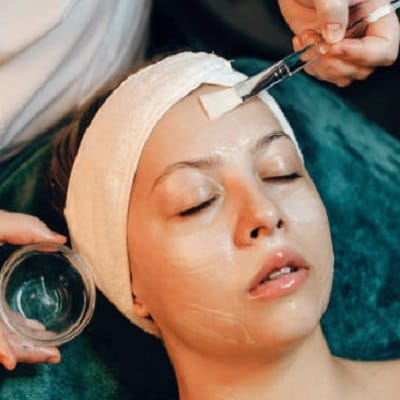
In the field of medicine, a chemical peel is the most often used cosmetic procedure to make the skin seem younger. Moreover, chemical peels may address a wide range of skin disorders, including acne scars, age spots, redness, melasma, rosacea, fine lines, and wrinkles. Additionally, used to treat acne scars are these peels. Furthermore, chemically produced peels are meant to eliminate dead skin cells from the top layer of the skin, thereby enhancing the skin’s look and giving it a youthful impression. Hence, in this blog, we will discuss What Is the Safest Chemical Peel for the Face?
What are Chemical Peels?
Chemical peels are beauty treatments that can work on the neck, hands, and face. Moreover, they make the face look or feel better. Furthermore, chemical solutions work in the area of treatment during this process. Therefore, this will cleanse the skin and finally cause it to peel off. In addition, the new skin that comes through is often smoother, less wrinkly, and may have less damage after this.
Dermatologists recommend chemic peels for a number of different reasons. They might be trying to treat a number of things, such as:
- Rough skin and little lines
- Sun damage
- Scars from acne
- Scars with darkening
- melanomas
- Skin color or an odd tone
Types of Chemical Peels:
- Mild Peels: The mildest kind of chemical peel, superficial peels—also called light peels. Moreover, it targets the epidermis, the outermost layer of skin.
- Medium Peels: Designed to solve more important skin problems, they reach the outer and middle layers.
- Deep Peels: Dermatologists recommend deep peels for more serious skin problems as they reach the layers underneath.
What Is the Safest Chemical Peel for Face?
Safety is first; hence, for individuals new to chemical peels or with sensitive skin specifically, superficial peels are usually the safest choice. Therefore, What Is the Safest Chemical Peel for the Face? Hence, the most common varieties of chemical peels are as follows:
Glycolic Acid Peels:
Alpha-hydroxy acids (AHA) generated from sugar cane consist of glycolic acid. However, usually skin specialists recommend it for superficial peels. Additionally, it is far more well-known for its capacity to pass through the pores and skin correctly.
Glycolic acid peels decorate skin texture, a useful resource in exfoliating dead pores and skin cells, lessening fine wrinkles, and even balancing pores and skin tone.
Safety: Although most people find these peels to be well-tolerated, to reduce the risk of irritation, start with a lower concentration—between 20 and 30%.
Lactic Acid Peels:
One additional AHA, lactic acid comes from milk. Appropriate for delicate skin, this is a milder choice than glycolic acid.
Lactic acid peels hydrate, gently exfoliate and enhance skin texture. Moreover, they also help really well with minor acne and hyperpigmentation.
Safety: A lactic acid is a safe option for people with sensitive skin or first-time peel users, as its mild character reduces the likelihood of irritation.
Salicylic Acid Peels:
One beta-hydroxy acid (BHA), well-known for penetrating greasy pores and skin and unclogging pores, is salicylic acid. It works thoroughly for skin liable to zits.
Salicylic acid peels clean pores and skin, lower oil manufacturing, and helps to limit acne destroy-throughs.
Safety: Generally speaking, these peels are safe for most skin types—especially oily and acne-prone skin—but individuals with sensitive or dry skin should exercise great care.
Selecting a Peel for Your Type of Skin:
Your skin type, objectives, and concerns will all affect the appropriate chemical peel you use. These rules should assist you in making a wise choice:
- To reduce sensitivity, use softer peels, including lactic acid or lower-concentration glycolic acid peels.
- Salicylic acid peels are very good for treating oily skin problems and acne.
- Glycolic acid and lactic acid peels assist in leveling out skin tone and lower pigment load.
- Glycolic acid peels help to improve general skin texture and ease fine wrinkles.
Potential Negative Effects:
Although surface chemical peels are usually harmless, one should be aware of some negative effects:
- After a peel, some redness and irritation are frequent; generally, these symptoms go away after a few days.
- The treated skin might become dry and start to peel, exposing fresh skin beneath.
- Chemical peels might increase sun sensitivity. So, it is essential to apply sunscreen and stay away from direct sun exposure after treatment.
Final Verdict:
Ultimately, the safest choices for face treatments are regarded to be superficial chemical peels like glycolic acid, lactic acid, and salicylic acid. Moreover, with little danger, these peels provide a variety of advantages, from curing acne and hyperpigmentation to enhancing skin texture. Furthermore, choose a chemical peel based on your skin type and particular issues. Therefore, always see a certified dermatologist or skincare specialist. Safely and efficiently obtain better, more brilliant skin with the correct peel and aftercare.
Book your appointment at SKN Cosmetics Islamabad for safe and effective peels that serve the purpose according to your desires.




